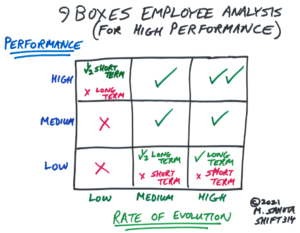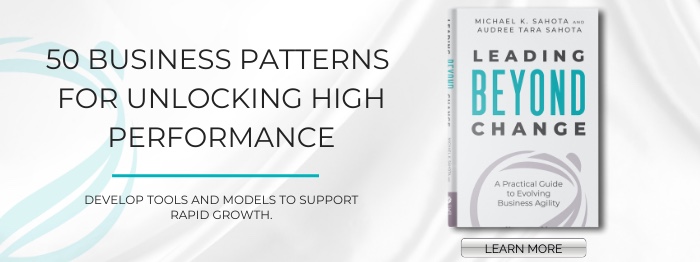Competency models are used by hiring managers and HR departments to assess whether employees have the skills needed to serve in their role. They can help managers determine how to build up employees’ capabilities so they can get their jobs done and excel in the role that they’re in.
Competency models also play a very important role in hiring and developing people, helping to understand where a person is now and how they can grow. However, competency models also have some major shortcomings.
The Challenge With Competency Models
The challenge with competency models is that competencies do not determine an employee’s success in the organization. What determines success is people’s actual ability to work together with others and learn how to adapt to the new environment.
To illustrate this, I’ll share a story from the organization NextJump as described in the book “An Everyone Culture” This organization was filled with brilliant engineers – all top talent. However, these people didn’t actually work all that well together as a team. While people had a lot of capability, they weren’t developing it. They weren’t growing as human beings. And the organization wasn’t performing as well as it should have been.

What happened? The top leadership actually replaced all these senior engineers with people right out of college – bright, enthusiastic people who were open to learning. They worked well together as a team and created great success for the company.
The Missing Link is Self-Evolution

While competency models are important to understand what people’s skills are and how well they could get the job done right now, the more important dimension is, how are these people growing, how well are they at collaboration, do they have the maturity to show up engaged and motivated within an organization?
This is the missing link. In this diagram – 9 boxes – there’s one dimension, which is how competent are they? How good of a producer are they – low, medium, or high? You can ask that about any person reporting to you. The horizontal dimension is about how good they are at growing
. Are they willing and open to learning and growing? What is their rate of evolution? Low, medium, or high?

The important thing to understand is that you may have someone who’s a high performer, but they’re not growing or evolving. Or you might have someone who’s a lower performer, but they’re really open to growth. As they evolve, they become more and more capable over time. The big message here is, it’s not just about competencies. It’s about their trajectory and rate of evolution.
What Is Evolutionary Capability?
What do we mean when we talk about people who have the ability to grow and evolve? We can start with Carol Dweck’s work about the growth mindset. We’re looking for people who are in a growth mindset, not a traditional mindset. We want people who are open to learning, who are open to feedback and who are ready to look at their mistakes.
In our work on Evolutionary Leadership, we go beyond the concept of the learning mindset. We talk about what we call the Evolutionary Mindset, which is when people choose to not just learn and grow, but willingly evolve themselves as a human being. To evolve their consciousness and unlock their potential in ways that go beyond traditional skills or training. The Evolutionary Mindset is the key to high-growth, high-performance organizations. Getting better at simple things like collaborating require people to work through their ego issues – that is a shift in consciousness.

Hire Great People (Don’t Worry About the Competencies)
Our approach is contrary to most of the advice about hiring – but most of the advice will lead you in the wrong direction. Our advice is to hire great people, and not to worry about the competencies and the skills. Don’t be too concerned about whether they have this certification, or know this specific technology, because the technology and skills required for the job are going to change over time. Most of what we learned in university doesn’t apply in the real-world workplace.
We’re really looking for people who are open to learning and growth and can rise to the challenge and have the desire and passion to succeed. That’s what we want. The whole focus on competencies, while they’re important, is a bit of a trap. It’s a red herring.
Instead of Competency Models, Use Tryouts
My daughter, who’s 22, just finished university and is applying for jobs. As I write this, she’s in a “tryout,” which means she’s spending two days at the company and they’re putting her through simulations to see how she shows up, how she works with other people, and how they tackle the challenges as individuals and as a group. This is the strategy I recommend using to evaluate potential hires to see whether they have the evolutionary capability to succeed.

This technology of tryouts can be invaluable for evaluating new people – and it is far more effective than a competency model at determining who is a good fit. Instead of trying to assess someone based on an interview or a test, you actually see how the person shows up in real life, in a real situation when the stakes are high. Tryouts create a context to see how effective people are at learning.
What to Look for During Tryouts
Here are some key items to watch out for.
How Open Are They to Feedback?
Explore people’s openness to feedback. Feedback is the birthplace of learning. You can give someone some authentic feedback and see how they respond. Are they authentic? Do they do a cover-up? Do they actually take it in and go, “Wow, that’s true. Oh my gosh, I don’t want to shop that way.” By looking at how people react, we can evaluate their openness to feedback.

The caveat here is that most people are terrible at receiving feedback. Even pretty evolved people are really, really bad at receiving feedback. There’s a part of our egoic structure that activates our internal critic when we’re told we’re doing something wrong or imperfectly. Even subtle shifts in the ability to receive feedback lead to an extraordinary shift in someone’s ability to grow.
How Do They Treat Other People?
What are the ear markings of people’s evolution? How can you tell how conscious they are, and how secure are they in their own being? Those who are more secure in their own wellbeing are more open to evolution.
One simple way to tell is to observe if they are able to create space and time for others. A person who is talking all the time, dominating the conversation, and taking control isn’t open to evolution and growth. A more evolved person supports the status of everyone else and creates space for other people to contribute.
Look not at what their contribution is towards the goal, but at how they’re treating the other team members. Look at whether they’re either enabling the brilliance of others or just trying to look good themselves. A person who is willing to support others in achieving greatness will create extraordinary results for the whole team.

Are They Focused on the Goal, or on Looking Good?
Where is the person focused? Are they focused on achieving the goal or on making themselves look good? Somebody who’s focused on the goal will support the group in whatever way is needed to create a successful outcome. It means that even if they’re very strong, dominant, people they’ll speak less. They’ll just create space for those people. They won’t try to argue over who has control. But the person who has this need to look good, they’ll say, “Oh, I need to be leading this group. Otherwise, I won’t be seen as a leader.” That will actually lead to a conflict to try to fight over control instead of achieving the purpose of the group.
The hallmark of more evolved leaders is that they’re in service of the purpose of the organization. It’s not about them looking good. More evolved leaders focus on how to make everyone else look good, because they know that’s what drives high performance.
Ultimately It’s About Evolutionary Capabilities
Ultimately what’s required to move from a traditional to a growth mindset to an evolutionary mindset is a permanent shift in our consciousness – our mindset and our worldviews. That’s the specific focus of all of our leadership programs from our initial offerings on leadership, all the way to our Academy of Leadership Mastery. It’s not just about making a shift, it’s about developing the evolutionary capabilities needed for ongoing growth.

What we share in these programs is a very specific technology for shifting consciousness in a business context, in a way that integrates both the very practical, external world practices for achieving results with the inner work of creating a shift in consciousness to show up as a different kind of human being, a different kind of leader.


